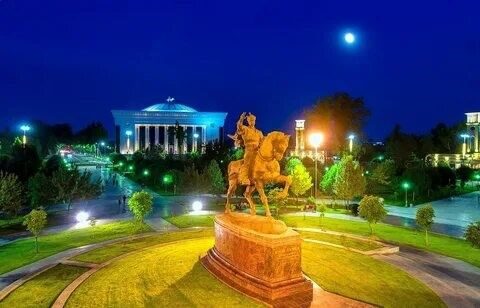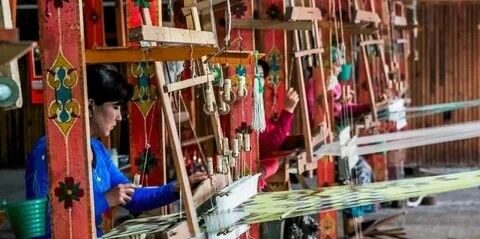
Tour to Uzbekistan 13 Days/ 12 Nights
Tashkent is a city where eras meet!
After breakfast at the hotel, visit the Hasti Imam ensemble - the shrine of Tashkent. The ensemble consists of the Barak Khan Madrasah, the Tilla Sheikh Mosque and the Kaffol Shashi Mausoleum, the Kukeldash Madrasah, built in the mid-16th century. Not far from the Kukeldash Madrasah, three renovated domes are visible - this is the reconstructed main Tashkent Friday mosque. It bears the name of the famous public figure Khoja Akhror (1404-1490), the chief sheikh of the powerful Naqshbandi Sufi order. Also a visit to the Chorsu bazaar - the oldest and largest farmers’ bazaar in Tashkent. After lunch, visit to the Alisher Navoi Opera and Ballet Theater, Amir Timur Square - the oldest public park in Tashkent; Independence Square is the largest square in the former Soviet Union. Dinner at a local restaurant. Overnight in a 4-star hotel.
After breakfast at the hotel, we travel by train through a mountain pass, where we experience the unique landscape of Uzbekistan, to Kokand. Lunch at a local restaurant. Kokand gave its name to the powerful Khanate in the 19th century, which stretched from the Fergana Valley to Tashkent and the southern Kazakh steppes. Visit to the Khudoyar Khan Palace, which was built despite social upheavals and wars between 1863 and 1872.
Next we go to Chust. Lunch at a local restaurant in Chust. The city is known for its craftsmanship, especially its knife traditions. We are going to Namangan. After a city tour in Namangan, we move on to Andijan (Andijan). Dinner at a local restaurant. Overnight in a 2-star hotel.
Homeland of the ruler of the Mughal Empire
After breakfast at the hotel, we will visit the historical city of Andijan, where the founder of the Mughal Empire was born and ruled in the 15th century. After this we will go to Fergana. After visiting the city of Fergana, we continue our journey to Margilan. Dinner at a local teahouse in Margilan. Overnight at a 2-star hotel in Margilan.
Margilan - the birthplace of silk production
After breakfast at the hotel, visit the Yodgorlik factory, where a group of Margilan lye growers have preserved the traditional production method. Lunch at a local teahouse. Then we will go to Rishtan. Rishtan produces almost 90% of the ceramics offered in Uzbekistan, and the production of ceramics in Rishtan has been passed on from father to son for about 800 years. We visit a family of ceramic artisans in Rishton. We will learn how to produce ceramics in the traditional way. In the afternoon we return to Tashkent by train. Free time in Tashkent and overnight in a 4-star hotel.
Khiva - Open Air Museum
After breakfast at the hotel, transfer to the airport and flight Tashkent – Urgench. Upon arrival in Urgench, transfer to Khiva (35 km). Visit to Ichan Kala (inner city). Khiva is the most isolated city on the Great Silk Road in Central Asia. Visit to the Madrasah of Muhammad Amin Khan (1852-1855), Kalta Minor ("Short Minaret"), built on the instructions of the khan in 1852, which was supposed to be the tallest minaret (70 m) in the Islamic world, but was abandoned (26 m ) after his death. Also a visit to Kunya Arka (Old Fortress) - the residence of the Khiva rulers Harem (Harem), mint, stables, arsenal, barracks, mosque, prison, which were located in the fortress. The mausoleum of Pakhlavan Mahmud is one of the most beautiful places in the city with its wonderful courtyard and excellent decoration. The Madrasah and Minaret of Islam Khoja (1908), Juma Mosque (Friday Mosque - 1788) attract with its 213 wooden columns, each with a height of 3.15 m - an architectural element borrowed from the ancient Arab architecture of mosque construction. After lunch, visit Tosh-Khovli (Stone House), built by Ala Kuli Khazh between 1832 and 1841 as an alternative to Kunya Ark and served as a harem (harem); Ala Quli Khan Madrasah (1835), bazaar and caravanserai. Dinner at a local restaurant. Overnight in a 3-star hotel.
Khiva → Bukhara: through the red miracle
After breakfast at the hotel, drive through the Kizil-Kum desert (480 km, M-37) to Bukhara. A short stop at the Bukhoro-I-Sharif teahouse in the middle of the trip for lunch - a picnic. The teahouse is located in an old caravanserai that served caravans for centuries. Arrival in Bukhara and hotel accommodation. Dinner at the Nadir Divan Begi madrasah with a folklore show. Overnight in a 3-star hotel.
Bukhara - the pearl of the east
After breakfast at the hotel, visit the Poi Kalon Ensemble (Foot of the Great). The square is separated by the Mir-I-Arab Madrasah and the Kalon Jumi Mosque. The Kalon Minaret (in Forsi – the Great Minaret) is one of the defining symbols. Also a visit to 3 domed bazaars - Taki Zargaron (1570 - jewelry bazaar), Taki Telpak Furushon (headdress bazaar) and Taki Sarrofon (currency exchange bazaar), located among a dozen specialized bazaars in the city; Magok-I-Attori Mosque - the remains of a Buddhist monastery, a Zoroastrian temple and the mosque of the Arab conquerors, which are located compactly and the Lyabi Hauz Square Ensemble, built around a reservoir in 1620. On the eastern side rises the Nadir Divanbegi Madrasah, built in 1630. On the western side of the square is Khanaka Nadir Divanbegi, the Ark fortress - a royal city as ancient as Bukhara itself. The fortress served as the home of Bukhara rulers for more than one millennium. Also a visit to the Bolo Hauz mosque (Mosque next to the pool - 1712) - the royal palace mosque; the mausoleum of Ismoil Samani - the most ancient building in the city and the mausoleum of Chashmai Ayub (Jacob's Source) - built in the 12th century above the source. Dinner at a local restaurant. Overnight in a 3-star hotel.
Bukhara - the pearl of the east
After breakfast at the hotel, visit the Ensemble of Bahauddin Naqshbandi - the tomb of the most famous and revered saint, one of the founders of the Sufi order - Hazrat Muhammad Bahauddin Naqshbandi (1318-1389). After lunch, visit Sitora-I-Mohi Khozha - the summer palace of the Emir, built by the Russians in 1911 for the last Emir Alim Khan and the monument Chor Minor (Four Minarets - 1807) - one of the most charming and unusual buildings in Bukhara. Dinner at a local restaurant. Overnight in a 3-star hotel.
Shakhrisabz - the birthplace of Amir Timur
After breakfast at the hotel, transfer to Shakhrisabz. Visit to Ak Saray (White Palace) – the summer residence of Tamerlane (14th century); Kok Gumbaz (Blue Dome) - Friday Mosque (15th century), built by Ulugbek in honor of his father. Also visit to Tamerlane's crypt - an underground room opened in 1963. Lunch in a private house. Transfer to Samarkand via Chirakchi. Dinner at a local restaurant. Overnight in a 3-star hotel.
Samarkand - in the footsteps of Timur's treasures
After breakfast, visit to Gur Emir (in Farsi - the grave of the emir) - the mausoleum of Timur and the Timurids (15th century), Registan Square - an ensemble of majestic madrassas (15-17th centuries), one of the best architectural ensembles in Central Asia and throughout the Islamic world. grandeur and splendor; Bibi Khanum Mosque (15th century) - a gigantic cathedral mosque, once the largest mosque in the Islamic world. Dinner at a local restaurant. Overnight in a 3-star hotel.
Samarkand - in the footsteps of Timur's treasures
After breakfast at the hotel, visit the Shahi Zinda (Living King) complex - the necropolis of the rulers and nobility of Samarkand, the Ulugbek Observatory (1420) - the remains of a huge (30 m high) astrolabe for observing the positions of the stars, part of a three-story observatory, the ruins of Afrasiab and a museum with fragments of frescoes VII century. Dinner at a local restaurant. Overnight in a 3-star hotel.
Al Bukhari - one of the holy places of Muslims
After breakfast at the hotel, the journey continues with a visit to the architectural ensemble of the mosque and mausoleum of Imam Ismail al-Bukhari. As a young man, Imam al-Bukhari (810-870) began traveling throughout the Muslim world to collect the oral traditions of hadith (the exemplary sayings and actions of the Prophet Muhammad). Of the more than 600,000 traditions collected by al-Bukhari, about 7,275 were compiled with complete genealogies of transmitters going back to the Prophet in a work he called Al-Sahih (Arabic: the present). For Sunni Muslims, this work is one of the six recognized collections of hadith. The mausoleum is located outside the city, 30 km north of Samarkand. Lunch at a local restaurant in Samarkand. At 16:00 transfer to the railway station. The Afrosiab high-speed train departs for Tashkent at 17:00 and arrives at 19:20. Farewell dinner at a local restaurant. Overnight in a 4-star hotel.
| Number of persons |
2 |
4 |
6 |
Supplement for single room accommodation |
| Tour cost |
2030$ |
1610$ |
1436$ |
320$ |
- Air-conditioned tourist vehicle with driver during the trip, transfers
- Hotels in "DOUBLE / TWIN" rooms, including breakfast
- Half board: all lunches * (7 lunches)
- English-speaking guide service throughout the trip
- Ticket for flight Tashkent-Urgench in economy class fare
- Ticket for flight Tashkent-Termiz in economy class fare
- Ticket for high-speed train series Afrosiab (Talgo 250) Samarkand-Bukhara in economy class City maps
- 24-hour agency assistance.
- Dinner (you can dine up to $7-15 per person in local and tourist restaurants)
- Personal expenses, additional services and tips
- Camera and camera fee (up to $5 nationwide).
- Visa
- International round-trip air tickets
At the following hotels or other hotels in similar accomodations:
- 1
Tashkent- Qushbegi Hotel - 4star
- 2
Samarkand- Al Madina Hotel - 3superior
- 3
Bukhara- Sahid Zarafshon- 4superior
- 4Khiva- Minor Hotel- 3superior
- 5
Nurata- Hayat Guesthouse
- 6
Yurta- Nazrulla Guesthouse
- 1Далеко-далеко за словесными горами в стране гласных.
- 2Маленький ручеек Даль журчит по всей стране
- 3Страна, в которой предложения залетают









